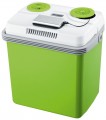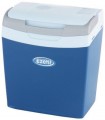Volume
The volume of the working chamber of the car refrigerator. The larger the volume, the more products can be loaded into the unit at a time. When choosing according to this parameter, it makes sense to select a model with a margin, because it is not recommended to load products too tightly — this adversely affects the quality of the device. On the other hand, note that the volumetric container and dimensions will have the appropriate ones.
Operation mode
—
Cooling. A mode of operation in which the food placed inside is cooled to a temperature just above zero (the minimum threshold is usually around 4 °C). Present in all car refrigerators by definition.
—
Freeze. An operating mode designed to cool the food placed in the cooking chamber to a temperature below zero (in some models down to -18°C). In some models, it can also be used for making ice in special compartments.
—
Heating. The mode of operation for heating products is especially useful in the cold season. Many models with this function have fairly good heating characteristics, allowing you to heat food in them to a hot state. This mode is also good for keeping food hot. However, car refrigerators with a heating function are usually quite expensive.
Max. heating at
An indicator of how many degrees the refrigerator is able to heat the product placed in it relative to the ambient temperature (if there is a heating function). Suppose a product at a temperature of +15 °C is placed in a refrigerator with a maximum heating of 60 °C; thus, the temperature of the product at the end of heating will be 75 °C, which is more than enough for the perception of food as warm and its comfortable consumption.
Min. cooling temperature
The minimum temperature to which the refrigerator is able to cool the product placed in it when operating in cooling mode. It should be taken into account that the minimum cooling temperature is not always achievable in fact: the actual cooling temperature depends on the ambient temperature and on the capacity of the refrigerator for maximum cooling (for more details on the calculation formula, see "Maximum cooling per (°C)"). However, this applies only to refrigerators that are not equipped with compressors (see Compressor);
compressor models are able to reach the minimum cooling temperature regardless of external conditions.
Сooling energy consumption
The power consumed by the refrigerator when operating in cooling mode. The greater this power, the more performant the refrigerator is, usually, and the less time it takes to cool the product. On the other hand, note that more power means more power consumption — which can be critical, for example, during long-term operation from a car battery (that is, when the car engine is turned off).
Features
—
USB for charging gadgets. A standard USB port that can be used to charge a smartphone or other gadget. Note that this function only works if the refrigerator is connected to the power grid — car refrigerators do not have their own batteries, and without an external power source, no energy will be supplied to the USB port.
—
Smartphone control. The ability to control the unit from a smartphone or other gadget, usually through a special application. The gadget itself is connected directly wirelessly, via Wi-Fi or Bluetooth. This function provides a number of conveniences. Firstly, it allows you to control the operation of the refrigerator from a distance. Secondly, the application on the smartphone is often more convenient and visual than the unit's own control panel. Thirdly, the gadget can receive various notifications from the refrigerator: settings, current status, notifications about malfunctions, etc. At the same time, control from a smartphone is not cheap, which is why it is quite rare, mainly in fairly advanced models.
—
Built-in fan. The presence of a fan in the working chamber of the refrigerator. Due to this function, improved air circulation inside the chamber is ensured, which contributes to better and more uniform cooling of the loaded products.
—
Battery discharge protection. A car refrigerato
...r with this function constantly monitors the battery condition when operating from a car battery (with the engine off). If the charge drops to a critical level, the unit “takes action”: it switches off automatically or signals the need to switch off. This allows you to avoid a complete battery discharge and unpleasant situations such as the need to start the engine “by pushing”.
— Interior lighting. The presence of internal lighting in the working chamber of the refrigerator. This makes it easier to use in low-light conditions — even in complete darkness outside, the contents of the chamber can be easily seen.
— Removable lid. The ability to remove the refrigerator cover from the main container. The meaning and features of this function may be different. So, in some models, the cover is removed only to make it easier to get to the contents and to make it easier to wash/clean the working chamber. In others, it may be possible to choose the side to which the cover will be folded. And some units with this function are equipped with two lids at once: one has a power cord and a cooler, when installed, the device functions as a refrigerator, the second is a simple heat-insulating cover that turns the car refrigerator into a thermos.
— Carrying strap (on the shoulder). Special strap that allows you to carry the device like shoulder bag. In fact, this function is most often equipped with bag models (see "Type"). In any case, such a strap significantly simplifies transportation: it is more convenient to carry a fairly heavy refrigerator on your shoulder, and your hands remain free. There are even models that can be carried like regular backpacks.
— Transportation wheels. The ability to transport car refrigerators like a cart is much more convenient than carrying them in your hands or on your shoulder, especially with large volumes and the corresponding weight of the model.Supply voltage
The supply voltage for which the car refrigerator is designed. There are several standard options:
—
12 V Standard voltage of the on-board mains of passenger cars, as well as many minibuses and light trucks. Supported by most modern car refrigerators.
—
24 V Standard voltage of the on-board mains of buses, heavy trucks and other large equipment; also found in some SUVs. Car refrigerators "only for 24 V" are almost never produced; as a rule, this option is provided in addition to 12 V.
—
230 V Powered by a standard household outlet. Usually a backup option, in case the refrigerator needs to be turned on outside the car for a while — for example, to pre-cool before a trip. In addition, units with such power can be used as an improvised replacement for a stationary refrigerator — for example, when going to the country, where there is no permanent refrigerator.
Energy label
A parameter that characterizes the efficiency of energy consumption. In modern car refrigerators, there are classes from A + and above; the more “pluses” in the marking, the more economical the device.
Note that the energy class does not describe the actual power consumption, but the efficiency of the device compared to similar models. Therefore, for example, a large
built -in A++ class unit may consume more energy than a smaller A+ class
armrest refrigerator.

